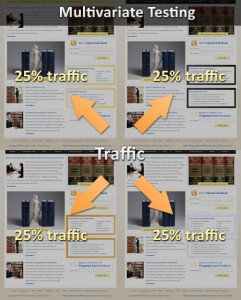Today we’re going to talk about testing. One of the things I love most about working in internet marketing is that you can track every click, follow every visitor through your website and monitor your return on investment very accurately. Testing allows us to take these statistics and turn them into real learning’s that can improve not only our website, for the user, but also to make them more efficient and profitable.
If you have a website that asks your customers/ users to DO something, then you need to be mindful of your user’s online experience. A user’s customer experience is very important in determining whether or not they will a) complete the transaction and b) come back again. On top of this, you must consider their brand experience while interacting with your website. In the internet/ digital/ web world this is known as User Experience (UX).
Business Analysis of your Website, Systems and Processes
When a business conceives a website, plans it, designs it and builds it, it’s unlikely that you will think of absolutely everything that is needed to create an excellent user experience and it’s even more unlikely that you will create a perfect website. As an aside, Bruce Clay has said in many SEO Toolset Conferences that I’ve attended that “SEO is about being the least imperfect“. Anyway, I digress. Once your website launches and you start to see transactions and conversions you will most likely want to see more.
To increase your website’s performance and effectiveness in generating sales you can do many things. You can improve your product, add more products or diversify to offer a wide range of products; you can also create, add to or improve your content – just to name a few. Your business may invest in more technology to improve your ability to segment your customer database and prospects to send them more relevant and targeted messages and communications. However once you’ve tried many of these things and seen some incremental growth with each new tactic, you start to run out of ideas. You might think that you have the best possible user experience you can achieve, that you’ve followed best practice. You have invested in all of the right systems and infrastructure and in getting an online marketing specialist to optimise your websites for search engines (SEO). You may also have streamlined your supply chain and your customer service might be top notch, so how do you continue to grow your improve your conversion rates to generate the highest return on investment (ROI)?
Multi-variant testing
Once you have exhausted all of the logical and rational ways of improving your website to drive the optimum sales, then you need to consider multivariate testing. Multi-variant testing is a principle whereby you start to change small or large parts of your webpages, generally your key promotional or transactional landing pages, in an effort to improve the desired action you want to see from your users.
For example, you have a homepage and it might have a large promotional banner across the top of your website with information about a product for sale. This may click through to a page to buy this product. You may also have alternate promotional spaces and a few different buttons on your homepage that direct users to different product pages with the hope they will convert to sales. If you were implementing a multi-variant testing schedule, you would systematically change each of these elements to see if your conversion rates improve. When conducting multi-variant testing you do not change several elements at the, not same time, you change them one after the other. So using the example above, you would change the colour of your buttons first and leave it for a week. All of your other promotional and marketing activity should remain the same. At the end of the week, you would then go to your Google Analytics website statistics (if you don’ have Google Analytics, get it ASAP, it’s free) and compare the previous week’s visitors, clicks and conversions to the current week to see if the change had any impact on sales and conversion rates. You keep the reports and you implement your second change in your multi-variant testing schedule.

This example shows how traffic was divided to go to 4 different landing pages to test the effectiveness of one placement using colour
You may choose to stay on the same area of the site and simple change the colour of the button again. This way you will have a 2nd test to qualify the first test. So if your original buttons were green and in week 1 of testing you changed them to be blue and received a small change but nothing significant, then in week 2 you changed them to orange and saw a larger spike in transactions or conversion rate, then you know that the orange has worked. The important thing to remember is that you need to try and keep all other activity consistent, otherwise you skew the results and your tests won’t deliver absolute results.
You would then repeat the testing moving systematically through your schedule of areas to test. If you have a Google account, then you have access to Google Webmaster Tools. If you have a web developer or have outsourced your website development to another company, then they will absolutely have Google Webmaster tools. These tools are also free and they are designed to help you conduct things like Multi-variant testing.
AB Sample testing
A/B Sample testing is often carried out in marketing communications. In an A/B sample test, you select a portion of your database or marketing schedule and you “ring fence” it off from the rest of your marketing activity. The idea is test with a small group of people so that if the test is not successful it does not impact on your monthly or annual revenue. A/B sample tests are testing only 1 fundamental difference. I have often used A/B sample testing for subject lines in emails. I split the database in 2 and send 50% one subject line and the other 50% the other subject line to see which one gets a better open and/ or click through rate.
Continuing using email marketing as the example, I may do an A/B sample test to understand if my email landing page could perform better. In this scenario, the email would be exactly the same for both email lists (split 50/50 in your test email list) but 50% would go to one landing page with very short content and information listed in a Question and Answer format and the other 50% will click through to a landing page with the same information but written in paragraphs and it would appear much longer. From the landing page, I would monitor the clicks through to conversion and of course the transactions.
A/B sample testing is much easier to be done manually if you don’t have fancy tools that allow you automate your testing schedule. Multi-variant testing can also be done manually, as I showed in the above examples, but it can get complicated and it requires a dedicated person to remember when and what was done at each time. If you have a larger budget and can invest in testing tools (which I’ve never had the luxury to enjoy) then the process may be different. But Google Webmaster tools are definitely a good place to start.

This Victoria's Secret example shows a classic AB Sample Test for a Marketing Promotion Landing Page
Testing, whether it’s A/B sample testing or complex and long term multi-variant testing, is absolutely fundamental to getting your user experience right as well as improving your website’s ROI. It will always pay off and often, the results are surprising. In my experience, I often find that beautiful design does not equal excellent conversions. Websites are about functionality and finding what you’re looking for as quickly and easily as possible.
For a much more in-depth analysis of multi-variant testing you can visit marketing experient’s website – this is a truly great read.
I’d love to hear your feedback if you use a different method for multi-variant or A/B sample testing or what your experiences have been when trying to implement some of the above.


Trackbacks/Pingbacks